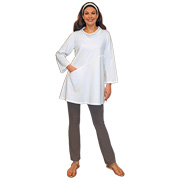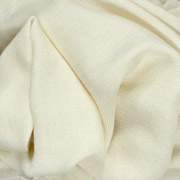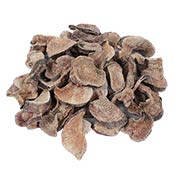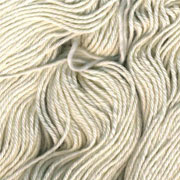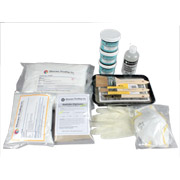VERSATILE: Fiber Reactive dyes are perfect for all natural fibers: cotton, viscose rayon, wool and silk - even wood and paper. They will not dye synthetics. They can be used as a vat dye, to paint with, or sprayed, splattered or squirted on, as a dip - whatever. The best for tie-dye.
TESTED: They have been in use around the world since 1956 and we have been selling them ourselves since 1969. If you are wearing cotton clothing there is a good chance that it was dyed or printed with Procion dyes since the dyes are widely used in industry. It is also the dye that is most widely used by professional tie-dyers.
BRILLIANT COLORS: The intensity of the colors can be made to range from light pastel to deep vibrant, almost neon colors. You control the intensity.
EASY TO USE: Cold (warm) water, no heating, use a plastic pail or a washing machine. On the following pages are instructions for some of the many methods of using the dye. As you will see, it's very easy to use - there's a way to use it to suit almost any situation. In addition, you can use our other dyes and paints with Fiber Reactives on the same project for fabulous effects.
COLORFAST: Fiber Reactive dye will not wash out - the molecules of the dye combine with the molecules of the fabric to create a permanent bond - the color becomes part of the fabric.
ECONOMICAL: These are the most economical of all our dyes to use. This is a powdered, highly concentrated dye which you add to water by the teaspoon. A 2 oz. package of a typical color can dye more than 10 T-Shirts.
STORAGE: If you store the powdered dyes in a closed container in a cool, dry place, they will remain usable for several years although gradually weaker. Once mixed with water, they should be used within a couple of weeks. After that, they produce less brilliant colors.
SAFE: Fiber Reactive dyes are considered relatively non-toxic, but, as when using any dye or chemical, use common sense. It is a fine powder and repeated inhalation of the dye powder can cause an allergic reaction in some people. Therefore, avoid continued breathing in of the dust by wearing a dust mask and providing proper ventilation. Some colors contain faint traces of Formaldehyde and/or copper which in California requires a special warning label. Although the dyes are not absorbed through the skin, you should wear rubber gloves. Dye stains on your skin can be removed easily with Reduran hand cream which we sell. Keep out of your eyes. Do not eat the dye.
Supervise children and pets - there is no telling what they might do. We know of no specific risks, but pregnant and nursing women need to be particularly careful with all chemicals. Best to discuss the matter with your doctor first.
CLEANING UP: Clean tools, buckets and washing machines with soap and water. You can add a little chlorine bleach if you like. Clean your skin with Reduran hand cleaning cream, it's the easiest way to remove stains.
DISPOSAL: Fiber Reactive dyes do not require any special disposal. You can safely pour them down the drain.
One environmental consideration is that if you have added Soda Ash to your dyebath, then it's alkaline (high pH) and can be neutralized by the addition of a little white vinegar (low pH). If you used vinegar or acidic acid in your dyebath, you can add some Soda Ash to neutralize the acid.
Highly acidic or alkaline waste water maybe could upset the balance in a septic tank. We have pH test paper you can use to test the pH before flushing it down the drain.
Who Are You?
For most people, dyeing is so easy that a child can do it, and thousands of children do. They get great, bright colors that make them happy. For most people a nice blue result that's exactly or close to what they expected is just fine. On the other hand, for those trying to match a color exactly, or repeat a previously created color, you need to know that dyeing is a craft and like all crafts there is a learning curve; one needs to read the information, and testing is required. Be advised - we do not guarantee the color result you wind up with will be what you wanted! Because, each Fiber Reactive color will produce a range of shades from pastel to vivid in its color range. The color produced depends on several factors that you control: the amount of dye used, the amount of time the fabric remains in the dye bath, the type of fabric, etc. For example: fuchsia can vary from a light pink to a dark magenta just by varying the quantity of dye used. Also, the colors do vary from dyelot to dyelot . To repeat a color exactly, you need the same dyelot. Different cotton fabrics dye into different colors. Therefore, the colors shown on our color chart should be used only as a guide in developing your own favorite colors.
The color chart is for cotton, not silk. On silk the colors shift - some more than others. In the extreme, the blacks on silk will yield eggplant, or with tints of maroon, red or green. Better to use a silk dye on silk for black and test the other colors first on your silk.
HAND DYEING IN A TUB
Dyeing 1 lb. of cotton, linen or rayon fabric (maybe 3-6 Sq. yds) or about 3 T-Shirts, all one color using a bucket, bathtub or big pail.
3 gal warm, not hot water
1/2 oz. (1 tablespoon) of dye *
1/3 cup (2 oz.) of Soda Ash
3 cups Plain Salt
2 tsp Calsolene oil (optional)
DYEING IN A WASHING MACHINE
Dyeing 8 lb. of cotton, linen or rayon fabric (maybe 24-48 Sq. yds) or about 24 T-Shirts, all one color, using a 20 gal. machine. 20 gal warm, not hot water
4 oz. (1/2 cup) of dye *
2 1/2 cups of Soda Ash
20 cups Plain Salt
2 Tablespoons Calsolene oil (opt)
DIRECT APPLICATIONS
As in any of the direct application tie-dye methods, handpainting, silkscreening, block printing, etc.
1 cup Soda Ash per gal of water for pre- soaking fabric
2 teaspoons of dye per cup of water for making liquid dye*
1 Tablespoon Urea per cup of water for making liquid dye
Some Thickener to thicken the liquid dye (optional)
* Technically, when dyeing all one color, the amount of dye used is a percentage of the weight of goods being dyed (%owg) which we show on the next pages for every color. For those who don't want to mess with weighing and calculating, we have estimated the equivalent in tablespoons.
Enjoy!




